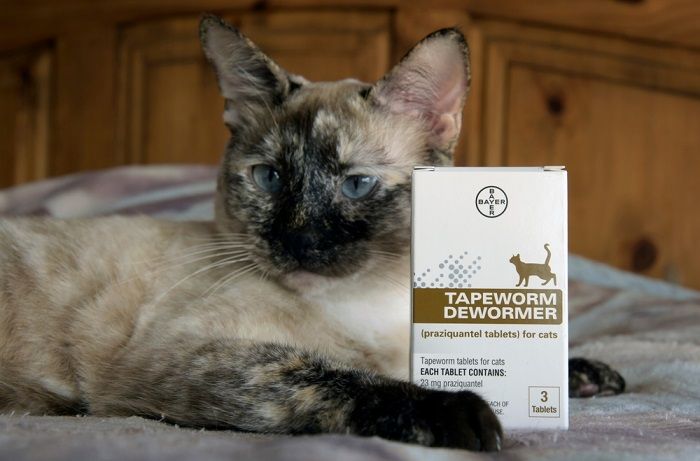
Our cats live closely with our families every day. Keeping them healthy and parasite free is extremely important. Intestinal parasites can occur in any age cat, and several types of intestinal worms infect our housecats.
Parasites such as roundworms, hookworms, whipworms and tapeworms cause weight loss, vomiting, diarrhea, and other gastrointestinal symptoms. Common tapeworms are a pesky example, and require specific treatment and prevention.
Tapeworms come in several varieties, with different species prevalent in certain environments. All tapeworms go through a life cycle that requires a host in order to mature and infect other animals. The tapeworms move from the egg form, or proglottid, through the larvae form, into an infectious form in the host. Eliminating the host can prevent reinfection for our pets.
Types of Tapeworms

When your cat grooms and ingests an infected flea, the tapeworm cysticercoid infects your cat’s small intestine.
In cats, Dipylidium caninum and the Taenia species are the most common. Echinococcus and Mesocestoides are less prevalent in our domestic felines. The two common tapeworm species are transmitted very differently. Let’s talk about how they get them and how to prevent them in your feline friend.
Dipylidium caninum requires an infected flea for transmission. The larval form of the tapeworm enters and lives in the stomach of the adult flea, then matures into a cysticercoid.
When your cat grooms and ingests an infected flea, the tapeworm cysticercoid infects your cat’s small intestine. One of the most common things your veterinarian will check for are fleas. If your cat has fleas, you will need to treat both the flea issue as well as the tapeworm infection.
Just treating the tapeworm will lead to reinfection if the fleas are not completely eliminated and prevented. There are reliable and safe flea prevention options, so be sure to discuss with your veterinarian which flea control would be best.
Taenia species infections require that your cat eat part of an infected rodent, such as a mouse or rat. The tapeworm larvae mature into a cysticercoid form and live in the gastrointestinal tract of the rodent. When your feline hunter consumes the rodent, the tapeworm cysticercoid matures and infects the feline small intestine, setting up infection.
How Will You Know if Your Cat Is Infected?

Most tapeworm infections in cats are asymptomatic, meaning that many cats don’t show any signs.
Tapeworm infections in pets are usually asymptomatic, meaning your cat may not show any signs. In severe cases, you might see vomiting or diarrhea, or in chronic cases, weight loss.These occur because the tapeworm’s mouth attaches to the wall of the cat’s small intestine and feeds there for weeks to months. If there are multiple adult tapeworms, an intestinal obstruction, or blockage, can occur and can be life-threatening.
The most common sign is the tapeworm segment.
These are small, white to cream-colored segments and look like grains of rice around the rectum or fur on the rear end. Your cat may scoot or have irritation around the anus.
The tapeworm segment is not the entire worm, though they may move around slightly. These are pieces of the tapeworm body and contain tapeworm egg packets. When these segments fall off the fur, they are then ready to infect again, waiting for flea larvae or rodent to come along and ingest the eggs to continue the cycle!
Diagnosis of tapeworms is confirmed by finding the eggs in the feces (a Fecal Ova and Parasite test) or by looking at one of the tapeworm segments under a microscope.
Your veterinarian can perform these tests, along with a full examination, to ensure your pet is otherwise healthy.
If you see the segments at home, you can use a piece of clear tape to preserve a segment. You can also bring in a fecal sample in a clean bag or plastic container. The specific species can be determined with a PCR (polymerase chain reaction) test at a diagnostic laboratory, though this is not generally necessary in order to treat.
Treatment and Prevention

Cats with tapeworms need the right treatment. An effective dewormer will wipe out the parasites.
Tapeworms are a parasite and we need to use an appropriate and safe dewormer in order to eliminate them. There are two approved deworming medications available, praziquantel and epsiprantel.
Also Read: Best Cat Dewormers
Your veterinarian will be able to provide the best medication based on your pet’s weight and health. The dewormer may be oral, injectable, or even topical. Once administered, the deworming tapeworm medication will kill the parasite, and your cat’s immune and digestive systems will break down the worm internally.
Prevention of Tapeworms in Cats
Prevention is key to avoid having to give medication for repeated infections. The Dipylidium species requires a flea for transmission, so flea prevention is essential.
It is important to discuss keeping all of your pets flea free, as it only takes two hitchhiking fleas from outside to cause a problem!
Taenia species from ingesting rodents can be trickier if your cat spends time outside, but limiting habitats for rodents can help.
Make sure to close off areas where pests like to hang out. These include under sheds, protected areas under porches, and unsecured waste receptacles. Provide opportunities to hunt at home, using puzzle feeders and toys that stimulate your cat’s predatory instincts.
Also Read: The 10 Best Cat Slow Feeders & Puzzle Feeders
While reports of natural remedies may sound tempting, no reliable or proven over the counter products exist that will eliminate the tapeworm.
Additionally, herbal and home remedies vary widely in quality and content, and may have toxic or damaging side effects. Be sure to ask your veterinarian before giving anything that is not prescribed.
Tapeworms in cats occur if your feline friend is a hunter or acquires a flea infestation. Thankfully, most tapeworm infections don’t cause significant health problems and may be asymptomatic.
If you see small grains of rice around the tail or in your cat’s feces, call your veterinarian for an appointment. Tapeworms are treatable with minima side effects and are preventable with good flea prevention and limited access to rodents.







